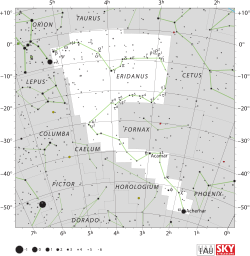Gliese 1062
| Gliese 1062 | |
 | |
| Observationsdata Epok: J2000.0 | |
|---|---|
| Stjärnbild | Eridanus |
| Rektascension | 03t 38m 15,69810s[1] |
| Deklination | -11° 29′ 13,5013″[1] |
| Skenbar magnitud () | 13,010[2] |
| Stjärntyp | |
| Spektraltyp | M2.5 VI[3] |
| U–B | +1,385[4] |
| B–V | +1,605[4] |
| Astrometri | |
| Radialhastighet () | -84,50 ± 0,63[1] km/s |
| Egenrörelse (µ) | RA: +1 458,094[1] mas/år Dek.: -2 696,796[1] mas/år |
| Parallax () | 61,8726 ± 0,0499[1] |
| Avstånd | 52,71 ± 0,04 lå (16,16± 0,01 pc) |
| Absolut magnitud () | +10,608[5] |
| Detaljer | |
| Massa | 0,255[6] M☉ |
| Radie | 0,411 ± 0,051[2] 0,372 ± 0,076[5] 0,202 ± 0,012[7] R☉ |
| Luminositet | 0,0055[2] L☉ |
| Temperatur | 3 488 ± 50[2] K |
| Metallicitet | -0,28 ± 0,15[7] (Fe/H) dex |
| Vinkelhastighet | 9,80[2] km/s |
| Andra beteckningar | |
| LHS 20, G 160-5, GJ 1062, 2MASS J03381558-1129102, NLTT 11462, PLX 757, RAVE J033815.6-112911, WISEA J033816.72-112941.4, Gaia DR2 5115463180914712448 [8][9] | |
Gliese 1062 är en ensam stjärna[6] i den norra delen av stjärnbilden Eridanus.[10] Den har en skenbar magnitud av ca 13,01[2] och kräver ett teleskop för att kunna observeras.[11] Baserat på parallax enligt Gaia Data Release 2 på ca 61,9 mas,[1] beräknas den befinna sig på ett avstånd på ca 53 ljusår (ca 16 parsek) från solen. Den rör sig närmare solen med en heliocentrisk radialhastighet på ca -85 km/s.[1] Den har en stor egenrörelse av 3,033 bågsekunder per år över himlavalvet.[12]
Egenskaper[redigera | redigera wikitext]
Gliese 1062 är en orange till röd dvärgstjärna av spektralklass M2.5 VI[3] och är en av de tre underdvärgar som 1940 identifierades av G. Kuiper.[13] Den har en massa som är ca 0,255[6] solmassa, en radie som är ca 0,202 – 0,411[7][5][2] solradie och har ca 0,0055 gånger solens utstrålning av energi[2] från dess fotosfär vid en effektiv temperatur av ca 3 500 K.[2] Stjärnan antas troligen ingå i halopopulationen och är en MACHO.[14]
Referenser[redigera | redigera wikitext]
- Den här artikeln är helt eller delvis baserad på material från engelskspråkiga Wikipedia, Gliese 1062, 23 maj 2021..
Noter[redigera | redigera wikitext]
- ^ [a b c d e f g h] Brown, A. G. A.; et al. (Gaia collaboration) (August 2018). "Gaia Data Release 2: Summary of the contents and survey properties". Astronomy & Astrophysics. 616. A1. arXiv:1804.09365. Bibcode:2018A&A...616A...1G. doi:10.1051/0004-6361/201833051. Gaia DR2 record for this source at VizieR.
- ^ [a b c d e f g h i] Houdebine, E. R. (2010). "Observation and modelling of main-sequence star chromospheres - XIV. Rotation of dM1 stars". Monthly Notices of the Royal Astronomical Society. 407 (3): 1657. Bibcode:2010MNRAS.407.1657H. doi:10.1111/j.1365-2966.2010.16827.x.
- ^ [a b] Gizis, John E. (1997). "M-Subdwarfs: Spectroscopic Classification and the Metallicity Scale". Astronomical Journal. 113: 806–822. arXiv:astro-ph/9611222. Bibcode:1997AJ....113..806G. doi:10.1086/118302. S2CID 16863021.
- ^ [a b] Mermilliod, J.-C. (1986). "Compilation of Eggen's UBV data, transformed to UBV (unpublished)". Catalogue of Eggen's UBV Data. Bibcode:1986EgUBV........0M.
- ^ [a b c] Houdebine, E. R.; et al. (May 2016). "Rotation-Activity Correlations in K and M Dwarfs. I. Stellar Parameters and Compilations of v sin I and P/sin I for a Large Sample of Late-K and M Dwarfs". The Astrophysical Journal. 822 (2): 38. arXiv:1604.07920. Bibcode:2016ApJ...822...97H. doi:10.3847/0004-637X/822/2/97. 97.
- ^ [a b c] Winters, Jennifer G.; et al. (June 2019). "The Solar Neighborhood. XLV. The Stellar Multiplicity Rate of M Dwarfs Within 25 pc". The Astronomical Journal. 157 (6): 32. arXiv:1901.06364. Bibcode:2019AJ....157..216W. doi:10.3847/1538-3881/ab05dc. 216.
- ^ [a b c] Kesseli, Aurora Y.; et al. (February 2019). "Radii of 88 M Subdwarfs and Updated Radius Relations for Low-metallicity M-dwarf Stars". The Astronomical Journal. 157 (2): 17. arXiv:1810.07702. Bibcode:2019AJ....157...63K. doi:10.3847/1538-3881/aae982. 63.
- ^ GJ 1062 (unistra.fr). Hämtad 2022-09-05.
- ^ "GJ 1062". SIMBAD. Centre de données astronomiques de Strasbourg. Hämtad 4 december 2016.
- ^ Sinnott, Roger W.; Perryman, Michael A. C. (1997). Millennium Star Atlas. Vol. 1. Sky Publishing Corporation and the European Space Agency. p. 308. ISBN 0-933346-84-0.
- ^ "The astronomical magnitude scale". International Comet Quarterly. Hämtad 2020-12-31.
- ^ Luyten, W. J. (June 1995). NLTT Catalogue. VizieR Online Data Catalog. Bibcode:1995yCat.1098....0L.
- ^ Kotoneva, E.; et al. (August 2005). "A study of Kapteyn's star". Astronomy and Astrophysics. 438 (3): 957–962. Bibcode:2005A&A...438..957K. doi:10.1051/0004-6361:20042287.
- ^ Fuchs, B.; Jahreiß, H. (January 1998). "Halo stars in the immediate solar neighbourhood". Astronomy and Astrophysics. 329: 81. arXiv:astro-ph/9708209. Bibcode:1998A&A...329...81F.





